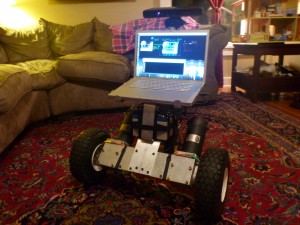I switched gears a few months back and have been focusing on developing for Virtual Reality and the HTC Vive. It has been a ton of fun digging deeper into Unity and sharpening up my C# skills. After attending a few hack-a-thon events in Seattle, focused around VR, my wife and I decided we should work on developing an Indie VR game for the HTC Vive. We recently were able to release that game on the Steam Store in their early access section for the Vive. It has been a ton of fun and we are still working towards full release in September.
Finally making some positive headway with the new collision avoidance on WARP. Zoey got some quality iPad time.
Using some of the voice commands I demoed at the last Seattle Robotics Society meeting. WARP takes voice commands for maneuver through the house. WARP is a proof of concept / prototype.
Using Google Earth to plot a course at the park. In prep for Robo-Magellan 2014. Felix does a pretty good job of following the path. There is slight displacement, and the course isn’t perfect, mostly because we are unsure of the exact starting location, and it is all dead reckoning from there. It uses a 9DOF IMU. Adam Green wrote the IMU classes to filter and process the values. It tracks really well. Need to figure out how to get a fix on the starting location.
A video showing status of Felix as we are prepping for the Robo-Magellan competition at Robothon 2014 in Seattle Sept 20th at the Seattle Center. This is to show some of the things going on inside Felix at this point. Target and path plotting using Google Earth, reactive collision avoidance. Also note he is running much faster through the house. With only a couple of weeks left, can we pull it together in time?
Early demo – the first pieces of the Robot MC display for Robothon 2014.
This is another iteration of seek with collision avoidance. In this piece I have increased the obstacle density. The obstacles represent 1 meter boundaries around lidar reflections. It is all reactive and there is no real path planning taking place.
WARP (Wheelchair Assist Robot Platform) shows off it’s collision avoidance and “Drive to Destination” targeting mode at the Norwescon SciFi and Fantasy conference in Seatac on Easter Sunday.
No children were injured despite their aggressive nature towards the robot.
The robot was very patient with the squishy life forms despite their continued taunting.
Early testing of the new prototype. I am excited to share this as I have been working long hours bringing this concept to reality. It is moving around in a confined space pretty well. There is still a lot of work to be done, but it is getting closer. Very excited!
Check out the latest Mechanized Stroller.
Robotic Stroller Conversion Kit Now Available for Purchase
Seattle, Washington – October 8, 2012 – For those of you who have the all-terrain strollers, now there is an easy way to turn your stroller into an autonomous robot. Purchase Xandon Frogget’s kit and within an estimated 20 minutes, you can convert your stroller into a robot that will drive autonomously. Or you can put it in ARAS mode and let the “autonomous robot assisted steering” drive itself around and avoid obstacles. This kit is intended for geek moms, dads or anyone looking for a solid platform for learning and discovering robotics.
There are three kit configurations for sale: Basic, Medium, and Complete Kit. The basic kit starts with all the hardware you need including either a Kinect or ASUS Xtion Pro but the buyer must provide the laptop/netbook and the stroller. The Medium is all the hardware including either a Kinect or ASUS Xtion Pro and a Netbook, but the purchaser provides the stroller. The complete kit includes all the hardware, the netbook, and the stroller. The kits are expected to retail for $2,500 – $3,500, depending on the configuration. (* See update at bottom)
The kit connects easily to most jogging strollers that are similar to the BOB Jogging Stroller and does not require any destructive modification. When you are done playing, you can return the stroller to its original configuration unharmed.
The wheelchair motors are rated for up to 300lbs, in case you need to use it as a porter to replace your Sherpa. And did we mention it is so quiet and that you can drive it around the house at night while everyone is sleeping?
In the demo video, Frogget is using a rooted NookColor to control the interface, showing off some of the unlimited possibilities. The sample code is written in Processing and can be modified easily so that any hackable device can steer it including a smart phone or Wii remote with Wii Wheel. Using software like Apple’s FaceTime or Google+ video chat, the robot can be teleoperated and provide a telepresence for grandparents everywhere, including the zoo.
The robotics stroller conversion kits will be built-to-order beginning mid October 2012. Please contact sales@daddiorobotics.com for purchases or inquiries.
Update August 3, 2013: We have suspended our current stroller conversion kit in order to focus on the new prototype. Apologies for all those who had been dreaming of getting a kit for fall 2013. Check back as we have exciting news coming.
I needed some running lights for a robot I have been working on; Brake lights, Turn signals, accessory lights etc. After reading an article the other day on how to make your own infinity mirror, I got the idea to use it on the robot and give a depth effect to the lighting system. I made up a prototype to be sure the effect would be easy to reproduce and look nice. I then spent several hours cutting and creating the aluminum housing, sandwiching a row of 11mm addressable RGB LED’s between a mirror (on the back) and a one way mirror (on the front). I ended up with these four corner lights for the robot. There is still some finishing work to do before mounting them, but the infinity mirror effect looks very nice I think. Mostly the lights will be used to display status and movement intent and will be greatly subdued so as to not look like a Vegas show. Of course there is always robot party mode where the robot plays disco and creates an interactive piano on the bed for little girls to jump around.
MiniBob is an early prototype for the Mechanized stroller. It was designed for Robothon 2012 to meet the weight requirement of 50lbs. He weighed in at 49 lbs.
In this video MiniBob takes his first steps! One caster is easier than two. Yeah! Wish MiniBob well on his competition Saturday at Robothon. Please let there be grey skies Saturday so that Felix and MiniBob are not blind.
The twins jumping on the bed trying out my virtual keyboard. Using techniques from the book “Making Things See” by Greg Borenstein, I was able to create a virtual matrix that floats above the bed. As the girls move through the matrix it plays different sounds based on their location.
This is one of the first iterations. I was trying out sounds to get a nice interaction that would be easy for the girls to anticipate and would hopefully spark more intrigue. This was a pentatonic scale of a single octave offset by 1 across the matrix. It still sounds fairly difficult to anticipate for the girls, but I think the piano works well. Next I hope to add more music and extend it by adding the skeleton mapping to allow for instrument selection that produces the sound. The instrument will be chosen by the location of the hands when an event is triggered. If the hands are at the side it will play piano. If one hand is at the shoulders it will play a stringed instrument along with piano and so on.
I want to add thanks to my neighbor Brian for his help getting the piano sounds, and to my sister Lorri for instructing me to use a pentatonic scale as well as provide a useful placement those notes on the matrix.


